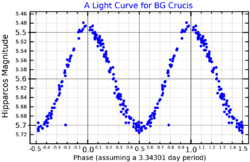Astronomy:BG Crucis
| Observation data Equinox J2000.0]] (ICRS) | |
|---|---|
| Constellation | Crux |
| Right ascension | 12h 31m 40.33011s[2] |
| Declination | −59° 25′ 26.1224″[2] |
| Apparent magnitude (V) | 5.49[3] (5.34 - 5.58)[4] |
| Characteristics | |
| Spectral type | F7Ib/II[5] (F5Ib - G0p)[4] |
| B−V color index | 0.622±0.012[3] |
| Astrometry | |
| Radial velocity (Rv) | −19.3±2.2[6] km/s |
| Proper motion (μ) | RA: −12.689[2] mas/yr Dec.: −4.110[2] mas/yr |
| Parallax (π) | 1.7777 ± 0.0873[2] mas |
| Distance | 1,830 ± 90 ly (560 ± 30 pc) |
| Absolute magnitude (MV) | −2.63[3] |
| Details | |
| Mass | 4.3[7] or 6.3±0.5[8] M☉ |
| Radius | 39.30+2.82 −3.23[2] R☉ |
| Luminosity | 1,033.93[3] L☉ |
| Surface gravity (log g) | 2.15[7] cgs |
| Temperature | 6,253±30[7] K |
| Rotational velocity (v sin i) | 22.0±1.8[9] km/s |
| Age | 63.7±15.8[8] Myr |
| Other designations | |
| Database references | |
| SIMBAD | data |
BG Crucis is a suspected binary star[11] system in the southern constellation of Crux. It is visible to the naked eye as a faint yellow-white hued point of light with an apparent visual magnitude that fluctuates around 5.49.[3] The system is located at a distance of approximately 1,830 light years from the Sun based on parallax, and is drifting closer with a radial velocity of −19 km/s.[6]
The visible component is a supergiant star that pulsates between spectral types F5Ib and G0p.[4] It is a small amplitude[12] classical Cepheid variable with an apparent magnitude ranges from 5.34 down to 5.58 over a period of 3.3428 days.[4] On the Hertzsprung–Russell diagram of temperature versus luminosity, it is located near the blue (hotter) edge of the Cepheid instability strip. Models indicate the cepheid region is relatively small in this star, so there are no shock waves produced as a result of the instability.[7]
BG Crucis is 64[8] million years old with four[7] to six[8] times the mass of the Sun. Having exhausted the supply of hydrogen at its core, it has expanded to 39[2] times the Sun's radius. It is radiating over a thousand[3] times the luminosity of the Sun from its enlarged photosphere at an effective temperature of 6,253 K.[7]
References
- ↑ "Hipparcos Tools Interactive Data Access". ESA. https://www.cosmos.esa.int/web/hipparcos/interactive-data-access.
- ↑ 2.0 2.1 2.2 2.3 2.4 2.5 2.6 Brown, A. G. A. (August 2018). "Gaia Data Release 2: Summary of the contents and survey properties". Astronomy & Astrophysics 616: A1. doi:10.1051/0004-6361/201833051. Bibcode: 2018A&A...616A...1G. Gaia DR2 record for this source at VizieR.
- ↑ 3.0 3.1 3.2 3.3 3.4 3.5 Anderson, E.; Francis, Ch. (2012). "XHIP: An extended hipparcos compilation". Astronomy Letters 38 (5): 331. doi:10.1134/S1063773712050015. Bibcode: 2012AstL...38..331A.
- ↑ 4.0 4.1 4.2 4.3 Samus', N. N; Kazarovets, E. V; Durlevich, O. V; Kireeva, N. N; Pastukhova, E. N (2017). "General catalogue of variable stars: Version GCVS 5.1". Astronomy Reports 61 (1): 80. doi:10.1134/S1063772917010085. Bibcode: 2017ARep...61...80S.
- ↑ Houk, Nancy; Cowley, A. P. (1979). Michigan catalogue of two-dimensional spectral types for the HD stars. 1. Ann Arbor, Michigan: Dept. of Astronomy, University of Michigan. Bibcode: 1978mcts.book.....H.
- ↑ 6.0 6.1 de Bruijne, J. H. J.; Eilers, A.-C. (October 2012), "Radial velocities for the HIPPARCOS-Gaia Hundred-Thousand-Proper-Motion project", Astronomy & Astrophysics 546: 14, doi:10.1051/0004-6361/201219219, A61, Bibcode: 2012A&A...546A..61D.
- ↑ 7.0 7.1 7.2 7.3 7.4 7.5 Usenko, I. A. et al. (2014). "Spectroscopic studies of southern-hemisphere Cepheids: Three Cepheids in Crux (BG Cru, R Cru, and T Cru)". Astronomy Letters 40 (7): 435. doi:10.1134/S106377371407007X. Bibcode: 2014AstL...40..435U.
- ↑ 8.0 8.1 8.2 8.3 Tetzlaff, N. et al. (January 2011), "A catalogue of young runaway Hipparcos stars within 3 kpc from the Sun", Monthly Notices of the Royal Astronomical Society 410 (1): 190–200, doi:10.1111/j.1365-2966.2010.17434.x, Bibcode: 2011MNRAS.410..190T
- ↑ Ammler-von Eiff, Matthias; Reiners, Ansgar (June 2012), "New measurements of rotation and differential rotation in A-F stars: are there two populations of differentially rotating stars?", Astronomy & Astrophysics 542: A116, doi:10.1051/0004-6361/201118724, Bibcode: 2012A&A...542A.116A.
- ↑ "TU Crv". SIMBAD. Centre de données astronomiques de Strasbourg. http://simbad.u-strasbg.fr/simbad/sim-basic?Ident=TU+Crv.
- ↑ Eggleton, P. P.; Tokovinin, A. A. (September 2008). "A catalogue of multiplicity among bright stellar systems". Monthly Notices of the Royal Astronomical Society 389 (2): 869–879. doi:10.1111/j.1365-2966.2008.13596.x. Bibcode: 2008MNRAS.389..869E.
- ↑ Stobie, R. S.; Alexander, J. B. (April 1970), "HR 4768 - a Cepheid variable of small amplitude", The Observatory 90: 66–68, Bibcode: 1970Obs....90...66S.
 |


